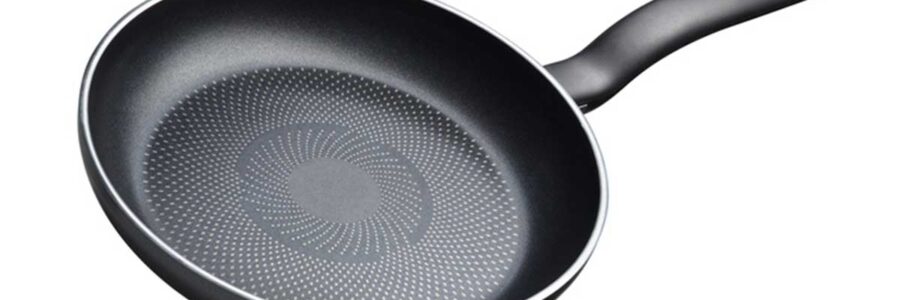Have you recently observed marks and dents on your cherished non-stick frying pan while making your morning meal? While seemingly trivial, these imperfections may have deeper implications than just interfering with your flawless omelet flip.
A significant study in the Science of the Total Environment journal has unveiled that even a minor scratch on a non-stick pan can liberate about 9,100 plastic microparticles.[1] These particles are not regular plastics like in soda bottles. They’re PFAS polymers, distinctively developed for non-stick layers.
Non-stick kitchenware, famed for its practicality, now raises health-related questions: What if these PFAS particles are ingested? The discovery has sparked a more profound discussion about the inner workings of these common culinary tools.
In this article, we dissect the research, demystify PFAS polymers, discuss potential health repercussions, and suggest alternatives for those apprehensive about the constituents of their meals and kitchenware.
PFAS Polymers: Beyond Common Plastics
While the term “PFAS” might sound foreign, their widespread utilization in products is undeniable. They’re special synthetic compounds with distinct properties that make them ideal for particular uses, notably in non-stick coatings.
PFAS and Their Unique Characteristics
Polymers are giant molecules with repeating smaller units termed monomers. PFAS is a subset of these polymers, notable for their repellent nature due to the fluorine atoms on their surface, offering them resistance against heat, water, and oil.[2]
Distinguishing PFAS from Ordinary Plastics
Though both fall under the polymer umbrella, PFAS have unique behavioral properties, setting them apart from everyday plastics in items like PET bottles.[3]
Role of PFAS in Non-Stick Surfaces
PFAS’s exceptional properties provide a sleek surface on cookware. But as the coating gets worn out, these particles might find their way into our meals.[1]
Highlighting the Research
A recent expose in the Science of the Total Environment journal has cast shadows of doubt over the safety of non-stick cookware.[1]
Research Aim and Approach
The investigation focused on releasing PFAS microparticles from non-stick pans during cooking. Through a simulation, the team observed the liberation of these particles from both new and used pans.[1]
Experimental Insights
The testing of varied pans and kitchen tools revealed a startling finding: A simple scratch could release approximately 9,100 PFAS particles into the simulated dish.[1]
Magnitude of Particles Released
The scale ranged from a few thousand to millions of such particles. Even slight imperfections could cause substantial releases. Furthermore, real-world releases could surpass the observed numbers, suggesting that these findings might just be a fraction of the actual scenario.
PFAS: A Health Quandary?
Cooking with such pans can introduce PFAS into our diet is troubling. The consequences of this go beyond mere culinary convenience and delve into the realm of health and wellness.
Potential Health Concerns
Ongoing studies suggest that PFAS might alter hormones, impact the immune system, and heighten the risk of some cancers.[4]
Regulatory Reactions
Noticing the probable threats, regulatory entities like the European Union are pondering over banning the whole class of PFAS polymers.[5] This move underscores the urgency to delve deeper into the matter.
Importance of Being Informed
Prioritizing your health means acknowledging the potential hazards linked with PFAS. Awareness allows us to adopt better kitchen practices and prioritize well-being.
Exploring Alternatives to Non-Stick Pans. There’s no need to compromise on cooking efficiency when sidestepping non-stick pans. Here are some alternatives free of PFAS:
Drawbacks of Non-Stick Pans
Apart from health hazards, non-stick surfaces degrade quickly, reducing pan longevity.
Alternative Cooking Surfaces
-
- Stainless Steel: Even heat distribution and long-lasting.
- Cast Iron: With proper seasoning, it offers a natural non-stick surface.
- Ceramic: PFAS-free, non-stick properties, though prone to chipping.
Tips for PFAS-free Cooking
- Use appropriate fats, preheat pans, maintain cast iron seasoning, and choose cooking tools wisely.
In Conclusion
Non-stick pan imperfections might be more detrimental than they appear. Given the associated health concerns, the potential release of PFAS particles demands serious attention.
As we deepen our understanding of these polymers, alternatives to non-stick pans become increasingly essential. Ultimately, the decision lies with us, possibly impacting our family’s health.
Regardless of your cookware choice, being informed lets you approach cooking with greater assurance. True culinary delight is about flavor and wholesome, safe nutrition.
References:
- Luo, Y., et al. “Raman Imaging for the Identification of Teflon Microplastics and Nanoplastics Released from Non-Stick Cookware.” Science of The Total Environment, vol. 851, 2022.
- “If Nothing Sticks to Teflon, How Does It Stick to Pans?” Scientific American, 5 Feb. 2001.
- Fenton, S. E., et al. “Per- and Polyfluoroalkyl Substance Toxicity and Human Health Review: Current State of Knowledge and Strategies for Informing Future Research.” Environmental toxicology and chemistry, vol. 40,3 (2021).
- “ECHA Publishes PFAS Restriction Proposal.” ECHA.


